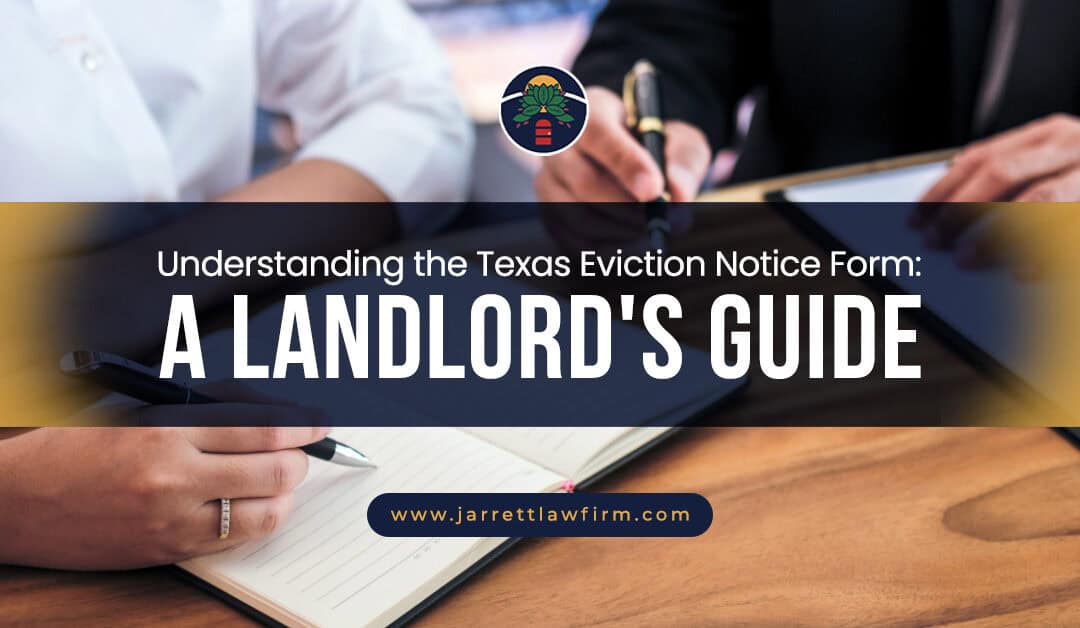
Handling property management in Texas involves understanding the Texas eviction notice form. This form is essential for landlords to protect their investments and manage tenant relationships effectively. Whether you’re new or experienced, the eviction process can be challenging and legally intricate.
The first step is understanding the legal requirements. Texas law mandates specific protocols for eviction notices, which vary depending on the type of lease violation, such as non-payment of rent or other breaches. This guide will simplify the Texas eviction notice form, explaining when and how to use it, common mistakes to avoid, and best practices to ensure compliance with Texas law.
Picture a scenario where a tenant has fallen behind on rent. You need to follow a structured process to issue an eviction notice legally. We’ll walk you through drafting and delivering the notice correctly. Different types of eviction notices, including the 3-day and 30-day notices, have specific requirements, and we’ll clarify these for you.
By the end of this guide, you’ll have a clear understanding of how to use the Texas eviction notice form effectively, ensuring you can handle eviction processes confidently and within the law. Let’s break down this complex aspect of property management together.
How Does the Eviction Process Work in Texas?
Understanding the eviction process in Texas is crucial for landlords. Whether you’re dealing with a tenant who has fallen behind on rent or has violated the lease agreement, knowing the steps ensures you handle everything legally and efficiently. Let’s walk through the process together.
Step 1: Identifying the Reason for Eviction
The first step is identifying a valid reason for eviction. Common reasons include:
- Non-payment of rent
- Lease violations
- Other significant breaches of the rental agreement
Texas eviction laws require a clear, legal reason to proceed.
Step 2: Issuing the Notice to Vacate
Once you have a valid reason, you need to issue a notice to vacate. The type of notice and notice period depend on the lease violation. For instance, a 3-day notice to quit is common for non-payment of rent.
This notice must be delivered in one of these ways:
- in person
- By certified mail
- Posted on the main entry door
Sending the copy by certified mail often makes the most sense because you can prove that you sent the notice to quit.
Step 3: Filing the Eviction Lawsuit
If the tenant continues to occupy the rental unit after the notice period, the next step is to file an eviction lawsuit at the local justice of the peace court.
You’ll need to pay court costs and provide evidence of the violation and notice given.
Step 4: Court Hearing
After filing the suit, a court hearing date will be set. Both the landlord and tenant will present their cases. It’s important to have all necessary documents, including the lease agreement, eviction notice, and proof of delivery.
If the court rules in your favor, a court order will be issued for the tenant to vacate.
Step 5: Removing the Tenant
If the tenant still refuses to leave, you may need to seek assistance from local authorities to enforce the court order.
This could involve a writ of possession, allowing law enforcement to remove the tenant and their belongings from the premises.
Additional Considerations
The eviction process can incur additional costs, such as filing fees and attorney fees. It’s also advisable to seek legal assistance to ensure all procedures are correctly followed according to the Texas Property Code.
Keeping thorough records and understanding your rights and responsibilities as a landlord can help avoid potential pitfalls and ensure a smoother eviction process.
Understanding these steps helps you manage your rental property effectively and legally, ensuring you can handle any tenant issues with confidence.
How Long is the Notice Period for Eviction?
Understanding the notice period for eviction in Texas is crucial for both landlords and tenants. This period can vary depending on the situation and the type of lease agreement in place. Let’s break down the specifics.
Three-Day Notice to Quit
If your tenant fails to pay rent, Texas eviction laws require you to issue a three-day notice to quit. This type of eviction notice informs the tenant that they have three days to either pay the past due rent or vacate the premises. You must deliver this notice in person, by certified mail, or by posting it on the main entry door if the tenant is not present.
Thirty-Day Notice for Month-to-Month Tenancies
For tenants on a month-to-month tenancy, a thirty-day notice is generally required. This gives the tenant thirty days to vacate the rental property. This type of notice is typically used when you do not intend to renew the rental agreement. It’s important to provide this notice in writing and to keep a copy for your records. Sending it via registered mail with return receipt requested is a good practice to ensure proof of delivery.
Notice for Lease Violations
When dealing with lease violations other than non-payment of rent, the notice period may vary. The Texas Property Code often requires a specific time period based on the nature of the violation. For example, if a tenant keeps a dangerous animal on the premises, you might need to issue a different notice period as dictated by the lease terms or local laws.
Court Proceedings and Eviction Suit
If the tenant does not comply with the eviction notice, you will need to file an eviction suit at the local justice court. This step involves filling out the necessary court forms, paying a filing fee, and attending a court hearing. The court will review the eviction case and decide whether to issue a court order for the tenant to vacate.
Additional Considerations
It’s important to follow the legally required steps to avoid complications. The notice must be clear, specifying the reason for eviction and the time period given to the tenant. If the tenant continues to occupy the rental unit past the notice period, you can seek a court order for forcible entry and removal. Legal assistance might be necessary to ensure all procedures are followed correctly.
By understanding these notice periods and their requirements, you can manage your rental property more effectively and avoid eviction-related issues. Keeping thorough records and following the proper legal procedures will help protect your rights as a landlord.
Our Experienced Real Estate and Eviction Attorneys Can Help
At Jarrett Law, we understand the complexities of managing rental properties and handling evictions. Our team is here to guide you through every step of the eviction process, from drafting a legally sound Texas eviction notice form to representing you in court.
Whether you’re dealing with non-payment of rent, lease violations, or other issues, we provide the legal experience you need to protect your investment. Let us help you navigate the legal requirements and ensure a smooth resolution to your eviction case.

